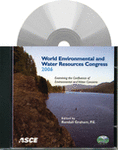Temporal and Spatial Variability in the Root-Reinforcement of Streambanks: Incorporating Variations in Soil Shear Strength and Soil Moisture into the RipRoot Model
Publication: World Environmental and Water Resource Congress 2006: Examining the Confluence of Environmental and Water Concerns
Abstract
The root-reinforcement of soils strongly affects bank stability, and the resulting delivery of sediment to channels. Estimates of root-reinforcement of soils have commonly been attained using perpendicular root models that simply sum root tensile strengths as a single add-on factor to soil strength. A major limitation of such perpendicular models is that the effect of variations in soil moisture and bank geotechnical properties on root-reinforcement are omitted. In reality, during mass failure of a streambank, some roots break, and some roots are pulled out of the soil intact; the relative proportions of roots that break or pull out are determined by soil moisture and shear strength, and root strengths. In this paper an equation to predict the frictional resistance of root-soil bonds was tested against field data collected at Long Creek, MS, under two soil moisture conditions. The root pullout equations were then added to the root-reinforcement model, RipRoot, and bank stability model runs for Goodwin Creek, MS, to examine the effects of spatial and temporal variations in soil shear strength and rooting density, on streambank factor of safety. Model results and field data showed that at low root diameters breaking forces exceeded pullout forces, but at higher root diameters pullout forces exceed breaking forces. The threshold diameter between root pullout and root breaking varied with soil shear strength, with increasing soil shear strength leading to a greater proportion of roots failing by breaking instead of pullout. Root breaking is the predominant mode of root-failure in dry soils, or those with higher shear strengths, whereas pullout of roots is more common in soils that are moist, or have lower shear strength. Resulting Factor of Safety (FS) values for the bank during the period modeled ranged from 1.36 to 1.74 with 1000 grass roots/m2, compared to a range of 0.97 to 1.37 for the non-vegetated bank. Root reinforcement was shown to increase bank stability over the entire range of soil moisture conditions modeled. However, the magnitude of root reinforcement varied in both space and time as determined by soil geotechnical properties and soil moisture.
Get full access to this chapter
View all available purchase options and get full access to this chapter.
Information & Authors
Information
Published In
Copyright
© 2006 American Society of Civil Engineers.
History
Published online: Apr 26, 2012
ASCE Technical Topics:
- Ecosystems
- Engineering fundamentals
- Environmental engineering
- Geomechanics
- Geometry
- Geotechnical engineering
- Material mechanics
- Material properties
- Materials engineering
- Mathematics
- Pullout behavior
- River bank stabilization
- River engineering
- Rivers and streams
- Shear strength
- Soil dynamics
- Soil mechanics
- Soil properties
- Soil stabilization
- Soil strength
- Soil water
- Spatial variability
- Strength of materials
- Uplifting behavior
- Vegetation
- Water and water resources
Authors
Metrics & Citations
Metrics
Citations
Download citation
If you have the appropriate software installed, you can download article citation data to the citation manager of your choice. Simply select your manager software from the list below and click Download.
